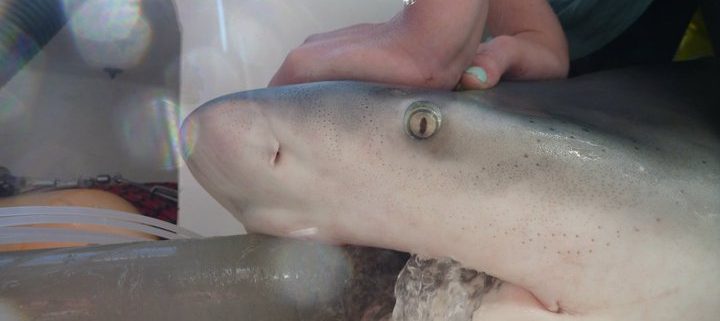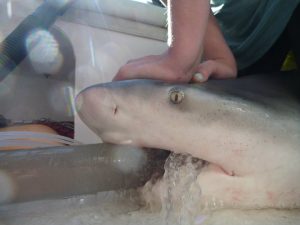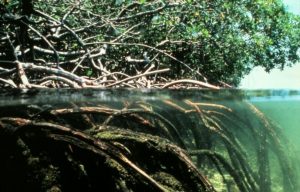Coastal Habitat Modification and its Impact on Sharks
by Fiona Graham, RJD Intern and Masters student
New canals are being built, waterways are undergoing modification, coastal urbanization is on the rise and mangrove, seagrass and other coastal vegetation cover is decreasing. Changes in coastal geomorphology alter sedimentation patterns and consequently the physical and biological structure of nearshore habitats is changing. Artificial habitats generally replace rocky reef substrate with smoother concrete structures and therefore differ from natural habitats in structural and surface complexity. These types of coastal habitat modifications are occurring on a global scale, and these changes can have lasting implications for the species that inhabit these areas. Some of these species include sharks, particularly those shark species that rely on coastal ecosystems for at least one stage of their life history.
One of these such species is the bull shark, Carcharhinus Leucus. Bull sharks are particularly vulnerable to coastal habitat modification due to their consistent use of estuarine and freshwater areas. They are one of the few shark species that are capable of tolerating freshwater for long periods of time, thereby resulting in increased encounters with humans. This overlap subjects them to increased anthropogenic impacts such as high fishing pressure and, of course, changes in the environments they inhabit.
A research study on the Gold Coast of Australia used long-term passive acoustic tracking to compare the bull shark’s use of artificial versus natural habitats in the area. They were able to determine that there was a noticeable preference for natural habitats and suggested that this partiality is due to the presence of mangroves and well-established tidal flows in these natural environments. The artificial canals lacked this type of vegetation and tidal flow has been greatly modified, resulting in the deoxygenation of the bottom layers. Although more studies need to be done, it is becoming evident that coastal development is restricting habitat use of nearshore areas by these shark species.
It is well known that these estuaries are essential nursery habitats for neonate and juvenile bull sharks, and removing juveniles from these areas before they are able to mature and reproduce can have serious conservation implications for the species. Consequently, the need to protect habitat important to these individuals is crucial to the conservation of their species. It has already been shown that bull shark populations are experiencing declines worldwide, and they are currently considered “Near Threatened” globally on the IUCN Red List. Other coastal shark species such as lemon sharks are also considered “Near Threatened.” In addition to the threats that sharks face due to anthropogenic impacts, their K selected life history traits make them particularly vulnerable to population declines, for example long life span and the fact that they are late to reach reproductive maturity and have few offspring.
Many other species of sharks also rely on nearshore habitats for nursery grounds. Mangroves support a diverse array of prey for juvenile sharks to feed on and provide a complex habitat structure that serves as protection from larger sharks and other marine predators. With the decline of these mangrove ecosystems, coastal habitat that is essential to these life history stages is diminishing. Sharks are important, both economically and within the ecosystem. Sharks can impact ecosystem structure and function through top down processes, and removal of these top predators from the ecosystem can result in cascading effects through trophic levels, disrupting community structure.
Restoration of coastal ecosystems, in addition to increasing the “naturalness” of artificial habitats could possibly help to alleviate the effects of coastal habitat modification on sharks. However, more research is needed into how and to what degree these changes in nearshore environments affect sharks and other species, and how these concerns can be mitigated.
References
Estes JA, Terborgh J, Brashares JS, Power ME, Berger J, et al. (2011) Trophic Downgrading of Planet Earth. Science 333: 301-306.
Heithaus, M.R., A. Frid, A.J. Wirsing and B. Worm (2008) Predicting ecological consequences of marine top predator declines. Trends in Ecology and Evolution, 4: 202-210
Nagelkerken, I. et al (2008) The habitat function of mangroves for terrestrial and marine fauna: A review. Aquatic Botany, 89, 2: 155-185
Simpfendorfer, C. & Burgess, G.H. (2009) Carcharhinus leucas. In: IUCN 2012. IUCN Red List of Threatened Species. Version 2012.2. <www.iucnredlist.org>. Downloaded on 19 February 2013.
Wen, C. K.-C., Pratchett, M. S., Shao, K.-T., Kan, K.-P. and Chan, B. K. K. (2010), Effects of habitat modification on coastal fish assemblages. Journal of Fish Biology, 77: 1674–1687
Werry JM, Lee SY, Lemckert CJ, Otway NM (2012) Natural or Artificial? Habitat-Use by the Bull Shark, Carcharhinus leucas. PLoS ONE 7(11): e49796.






Leave a Reply
Want to join the discussion?Feel free to contribute!